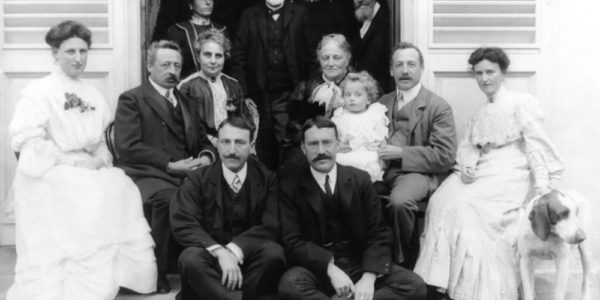It all started with a contact and a few intriguing photographs. An environmental engineer reached out to Wikimedia CH’s Programme Innovation team, which was working on climate-related initiatives, and shared a set of historical images. The photographs depicted members of a Swiss family living in the Mugello region of Tuscany, as well as portraits of farmers and rural life just before the First World War.
What began as a search to better describe these photographs on Wikimedia Commons Category:Dapples Archive led to something much more. The deeper the research went, the more fascinating the narrative around the Dapples family became—one that helped shape fields like agriculture, medicine, sports, and even climate science. This led to the discovery of a rare and nearly forgotten collection of family albums, carefully preserved in the Museo Casa d’Erci, a small ethnographic museum in the village of Grezzano, in the municipality of Borgo San Lorenzo.
Among the surprising discoveries:
- Edmond Dapples, after the premature death of his wife, abandoned his career as a physician and retired to the Mugello region of Tuscany, where he founded an innovative and forward-thinking farm estate that transformed degraded mountain land through large-scale reforestation.
- His nephew, Louis Dapples, became CEO of Nestlé. He played a key role in restructuring the company to survive the Great Depression and helped launch Nescafé.
- Louis also personally funded the creation of the Epilepsy Research Centre in Zurich, following the tragic death of his young son from epileptic seizures.
- His brother, Henri Dapples, was a member of the team that won the very first Italian football championships. He played a key role in introducing and developing football in Italy.
- As early as 1914, the estate and its farms were entrusted to Edmond’s daughter, Elvire Dapples, a philanthropic, and innovative woman. She managed the property until the 1960s, contributing to the social and environmental well-being of the region.
Later research showed that their reforestation work in the Mugello aimed to preserve the landscape and prevent hydrogeological disasters. For example, the devastating 1966 flood of Florence has been linked in part to widespread deforestation in the Tuscan Apennines, much of it caused by military activity during WWII.
This research uncovered a second, deeply connected narrative. The same environmental engineer who first shared the Dapples photographs later introduced the archive of Giampiero Wirz, another environmental engineer who had documented the the Bosco degli Svizzeri, a reforestation project in the Mugello.
This reforestation effort, carried out by students from ETH Zurich in the aftermath of the 1966 Florence flood, was a direct response to the environmental devastation caused by deforestation during World War II. In many ways, it echoed the original vision of the Dapples family: that forestry is essential for flood prevention and hydrogeological stability.
What began as a few images has evolved into a broader exploration of Swiss contributions to environmental resilience.
This journey didn’t just enrich Wikimedia platforms—it also inspired new programmatic activities at Wikimedia CH. Insights from the Dapples Archive became a foundation for the Wikiklima project, where the family’s 19th-century forestry practices can inform climate change response today.
Where might your own curiosity lead? Whether it’s uploading a photo, editing a Wikipedia article, or diving into historical research, every contribution helps build the world’s free knowledge. Join a Wikimedia project—you never know what you will uncover!
Dive deeper into the story




